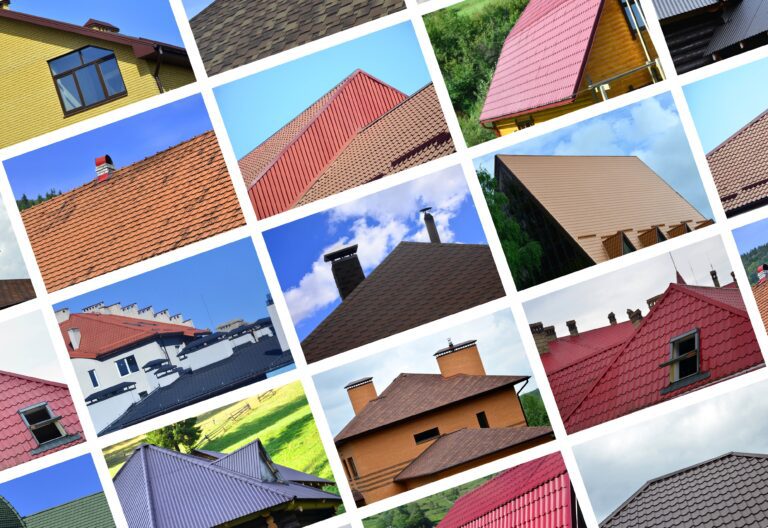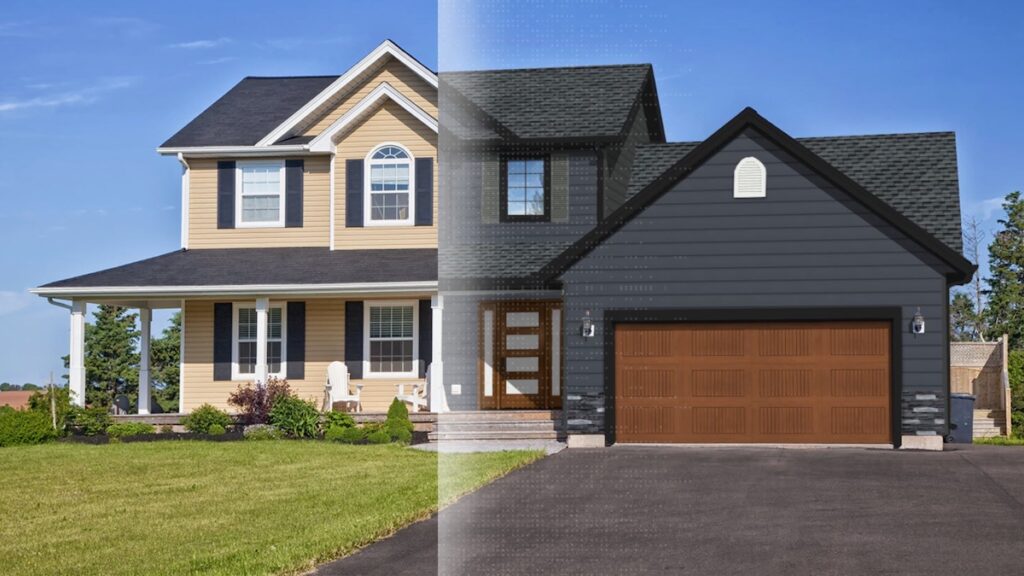Choosing the Best Roofing Material for Your Home
Your roof does more than protect—it defines your home’s style, efficiency, and longevity. Whether you’re considering durable asphalt shingles, energy-efficient metal, or timeless slate, selecting the right material is key to a lasting investment.
Key Considerations for Your Roof:
- Lifespan & Durability – Asphalt (15-30 yrs), Composite (40-50 yrs), Slate (100+ yrs)
- Energy Efficiency – Metal and clay tiles reflect heat, lowering cooling costs
- Weather Resistance – Metal withstands storms, slate resists fire, clay handles coastal air
- Aesthetic Appeal – Choose from modern metal, classic wood, or architectural composite
- Budget-Friendly Options – Asphalt is cost-effective; high-end materials offer long-term value
See how your home could look with our Roof Visualizer—explore materials, colors, and styles instantly.
Introduction
Ever looked up at your roof and wondered what secrets lie within its layers? The type of roof above our heads does more than just shield us from the elements—it shapes the comfort, efficiency, and even style of our homes. From classic clay tiles that whisper tales of ancient architecture to sleek metal sheets reflecting modern minimalism to everyday asphalt shingles each roofing material tells a story.
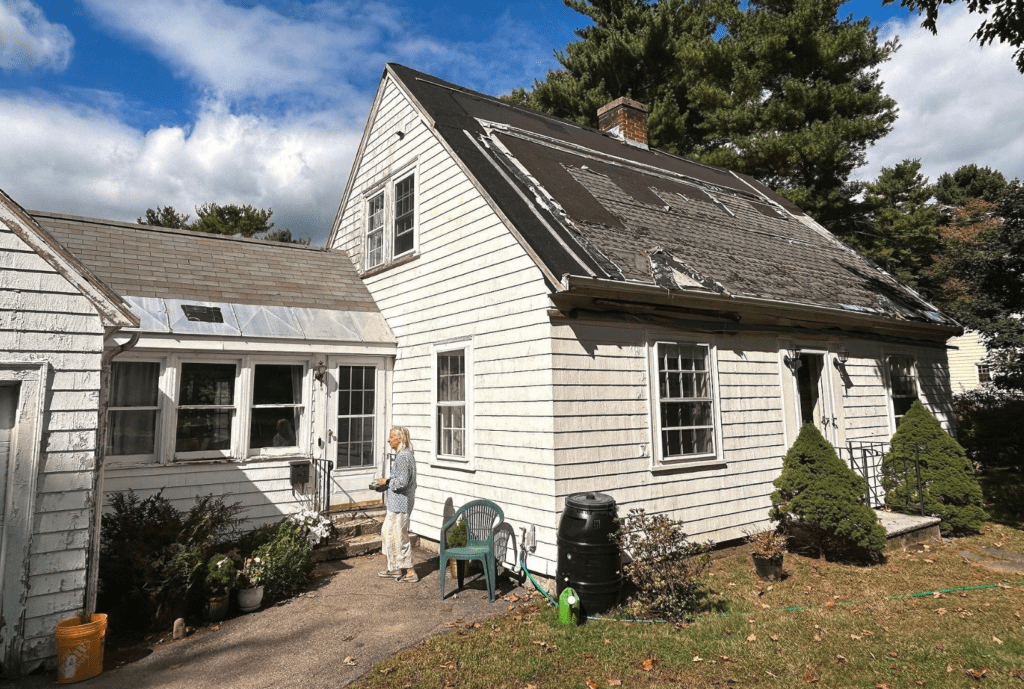
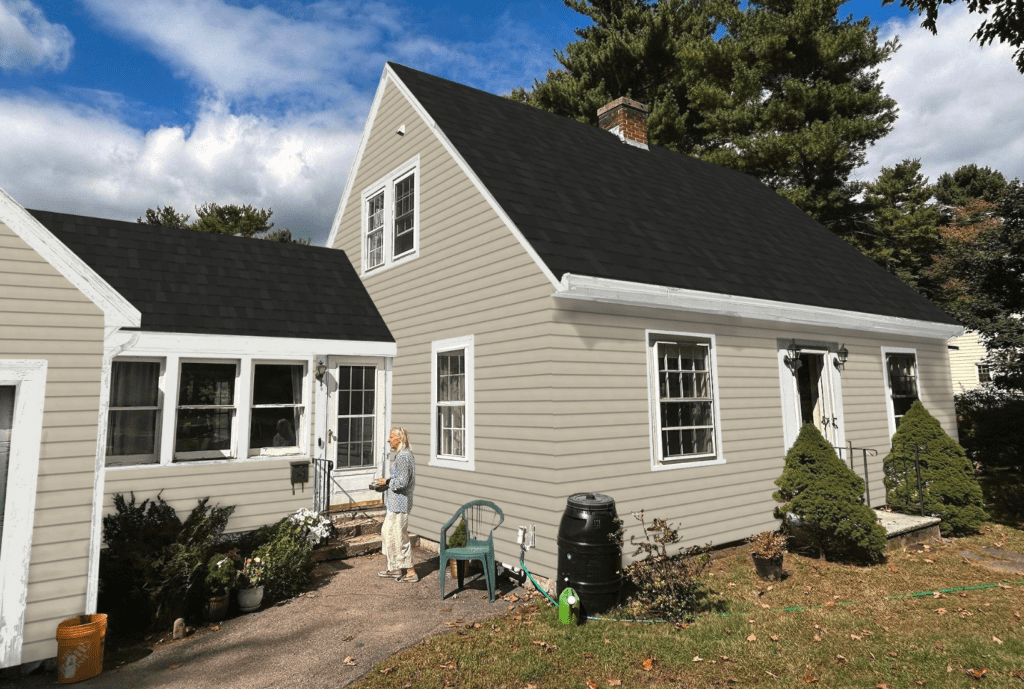
ROOFING VISUALIZER TOOL
See Your Home with a New Roof in Seconds
Help your homeowners visualize new roofing and colors on their own home with Renoworks’ AI technology in seconds.
- Easy-to-use interface designed for contractors and professionals working with homeowners.
Asphalt Shingles
An asphalt roof is a popular choice for many homeowners due to the versatility of asphalt shingles and low roof cost. Let’s dive into what makes them stand out.
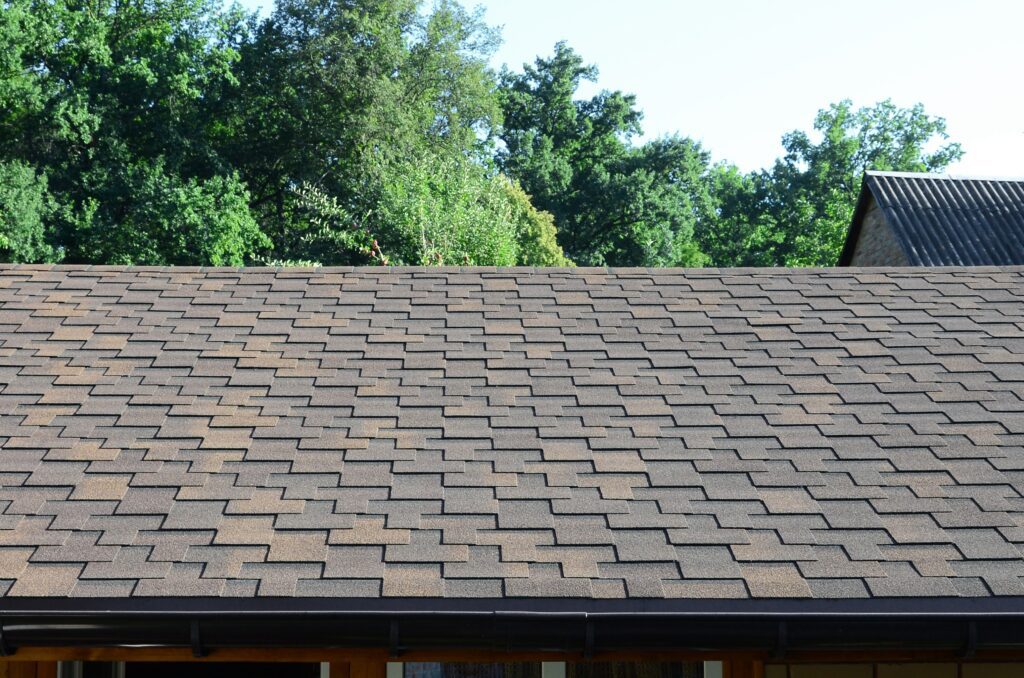
Definition and Composition
An asphalt shingle roof consists of fiberglass, tar, and asphalt granules on a fiberglass mat. These components work together with roof decking, flashing, underlayment, drip edge, ice-and-water shield ridge, capping, roof vents, and pipe boots to create a durable roofing system. Asphalt roofs are also great for pitched roofs.
Benefits
Versatility: They can cover various angles shapes forms making them suitable for almost any type of roof.
Design Variety: Available in multiple styles like 3-tab dimensional premium that mimic other materials such as slate cedar shakes.
Color Options: Offered in a wide range of colors which enhance many different home styles’ curb appeal.
Cost-Effective: Provide high performance at a lower roof cost compared to other roofing materials.
Lifespan
These roof shingles typically last between 15-30 years depending on the quality, installation, climate conditions, and maintenance practices. An asphalt roof offers long-term reliability at a lower roof cost that doesn’t break the bank.
Quality Level | Expected Lifespan |
|---|---|
Basic | 15-20 Years |
Mid-range | 20-25 Years |
High-end | Up to 30+ Years |
Maintenance Tips
Regular inspections by you or a professional residential roofing contractor of an asphalt roof, especially after severe weather, helps to detect potential issues early. You’ll want to make sure the following is being done:
Clear debris from gutters downspouts
Check for missing or damaged shingles and replace promptly
Inspect attic ventilation to prevent moisture buildup
Ensure flashing around chimneys skylights is intact to avoid leaks
By following these tips you can extend your shingle lifespan, maintaining your home’s protection aesthetic appeal over time!
Clay Tiles
Definition and Composition
Clay tiles are a roofing material made from natural clay, prized for their durability and aesthetic appeal. These tiles come in various shapes, colors, and applications. Their unique Old World charm makes them a popular choice for homeowners looking to add beauty to their homes.
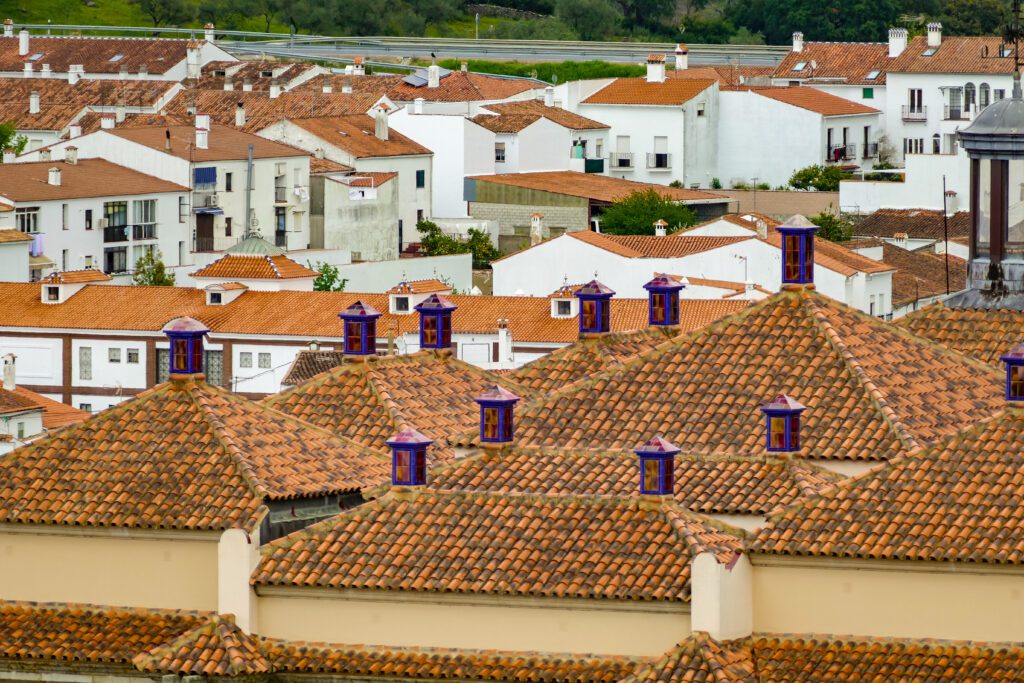
Benefits
Durability: Clay tile roofs are fire resistant and withstand threats like wind, sun, snow, and hail.
Insulation: Clay tiles keep homes cool during hot weather while maintaining warmth in cold conditions.
Longevity: Properly installed clay tile roofs by a professional roofing contractor last over 100 years with routine maintenance.
Extreme Weather Resistance: Terracotta tiles resist damage from salty air and extreme temperatures making them ideal for coastal areas.
Energy Efficiency: By emitting rather than absorbing heat they increase energy efficiency by reflecting the sun’s UV rays.
Lifespan
With proper installation and maintenance, clay tile roofs can easily surpass 100 years of service life for your residential roof, ensuring long-term reliability, elegance, and sustainability.
Installation Considerations
Installing clay tiles requires expertise due to their weight which requires strong roof structures, accurate placement, and skilled labor to ensure optimal performance longevity. You’ll likely want to hire a roofing contractor that is an expert in these types of roof styles.
Composite Shingles
Composite shingles are my go-to recommendation for anyone looking to balance durability, aesthetics, and roof cost. These versatile materials offer a great mix of benefits that make them stand out. A composite shingle roof is an excellent choice for most homeowners if you can find a roofing contractor that installs them.
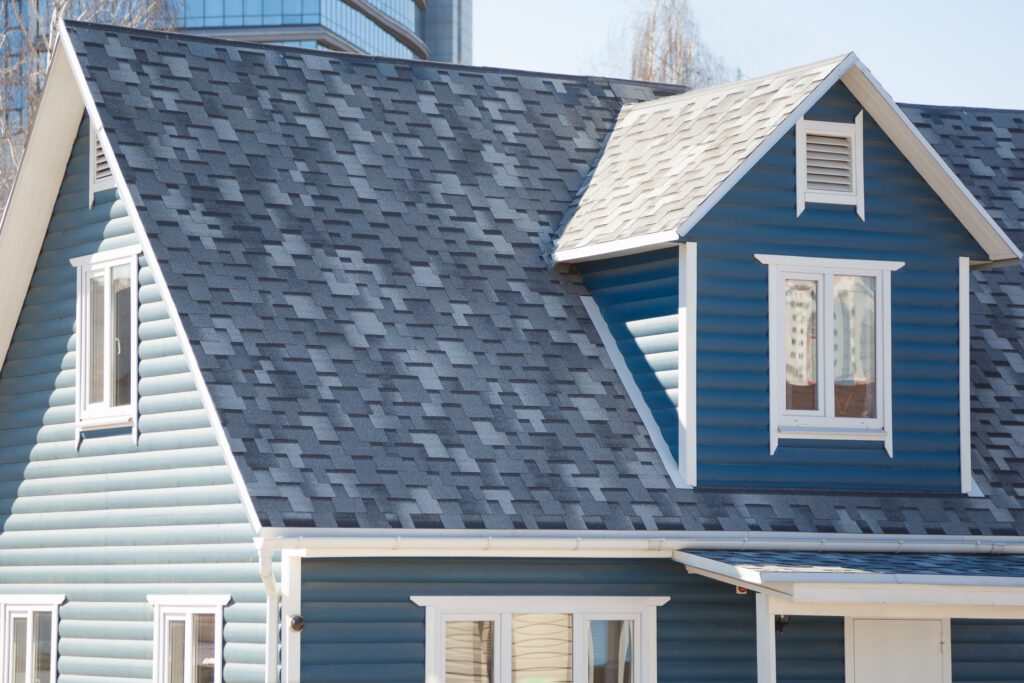
Definition and Composition
So what exactly are composite shingles? They’re made from a blend of different materials like synthetic polymer, recycled stuff (think plastics), slate bits, laminate layers, and sometimes wood fibers. The idea is to create something that looks as good as expensive options like slate tiles or wood shingles but without the hefty roof cost.
Benefits
Durability: One thing I love about composite shingles is their toughness. They’re built to withstand harsh weather conditions—whether it’s strong winds or scorching UV rays.
Long Lifespan: If you hate the thought of replacing your roof every couple of decades, you’re in luck with these babies—they can last between 40 and 50 years! That’s way longer than traditional asphalt shingles most folks use and is even better for pitched roofs which can have a higher roof cost to replace.
Fire Resistant: Safety first! Composite shingles have excellent fire resistant properties which add an extra layer of protection for your home.
Lifespan
When thinking long-term investments for your home exterior and roof type look no further; composite shingles provide longevity rarely matched by other materials such as asphalt shingles– we’re talking up till half-a-century here!
Cost vs Traditional Roof Shingles
Now let me break down costs because what homeowner doesn’t care about budget? While initial installation by a roofing contractor might be pricier compared directly against regular old-fashioned asphalt types, when considering lifespan plus low-maintenance, overall expenditure evens itself beautifully making composite shingles a worthy consideration indeed. Especially if peace-of-mind figures high on your priority list during storm seasons etcetera…
Material | Average Lifespan | Initial Cost |
|---|---|---|
Asphalt Shingles | 20-30 Years | Lower |
Composite Shingles | 40-50 Years | Moderate |
Environmental Impact
If you’re looking for a green roof, composite shingles have eco-friendly credentials covered too since many versions incorporate recycled components. This reduces landfill waste significantly whilst delivering exceptional performance – double-win right there, ensuring a guilt-free ownership experience across the board for environmentally conscious homeowners alike…
Concrete Tiles
Concrete tiles are an awesome roofing material I often recommend due to their durability and aesthetic appeal. They bring a unique combination of strength and style that can enhance any home’s look.
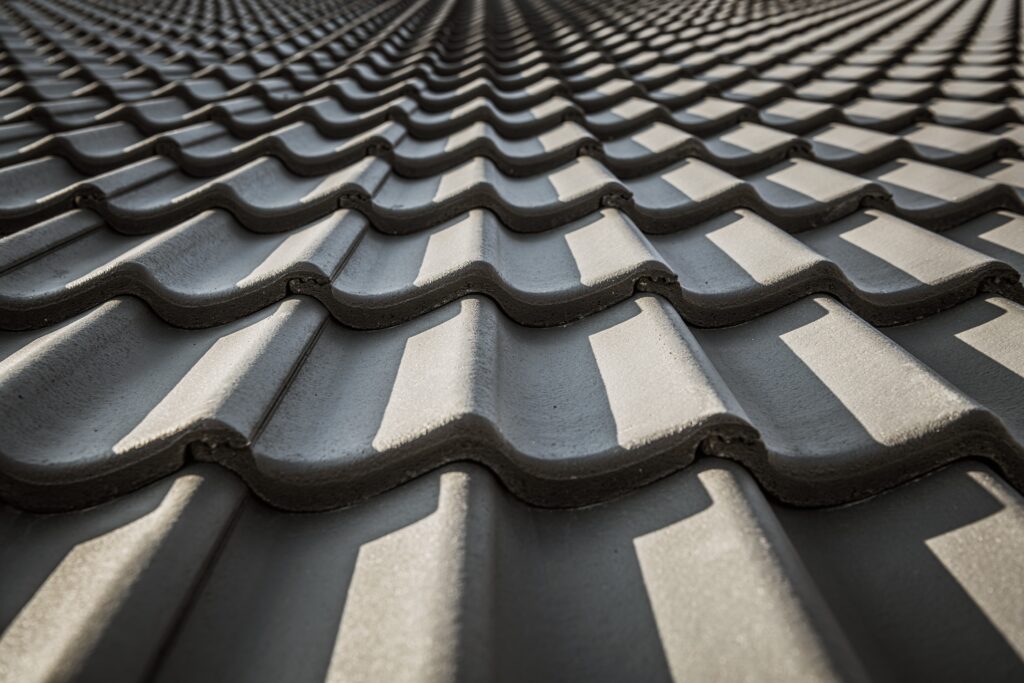
Definition and Composition
So, concrete tiles—what exactly are they? They’re made from cement, sand, and water mixed together under high pressure and heat. This process creates strong, durable roofing materials available in various colors and profiles. Homeowners get the flexibility to choose styles matching their house design perfectly.
Benefits
Let me tell you why concrete tiles rock:
Durability: These bad boys resist weathering like champs! Cracking or breaking isn’t something you’ll worry about with these on your roof.
Strength: Ever worried about heavy loads or extreme weather conditions? Concrete tiles got you covered—they withstand it all without flinching.
Lifespan
One thing I love most is how long-lasting concrete tiles are; we’re talking 50 years or more when properly maintained (according to authoritative sources). That’s decades of peace of mind knowing your roof’s not going anywhere anytime soon!
Weight Considerations
Now here’s where things get interesting—they’re heavier than other options out there (like asphalt shingles), which means extra structural support might be necessary for some roof styles but trust me—it’s worth every pound given its advantages!
Material | Average Weight per Square |
|---|---|
Asphalt Shingles | 200-300 lbs |
Concrete Tiles | 820-1100 lbs |
This table shows just how much weight difference exists between common materials used today.
Installation And Maintenance
Installing these requires professional help from a roofing contractor because precision matters—a lot! Improper installation could lead up costly repairs down the line adding to the overall roof cost so always hire experienced pros who know what they’re doing inside-out right off the bat rather than regretting later…you’ll thank yourself eventually believe me. Once installed though, maintaining them couldn’t be easier! Regular inspections and cleanings keep everything tip-top shape ensuring longevity.
Metal Roofing
Metal roofing is a roof type gaining popularity for its durability and energy efficiency. It’s a solid choice whether you’re re-roofing your home or a commercial building.
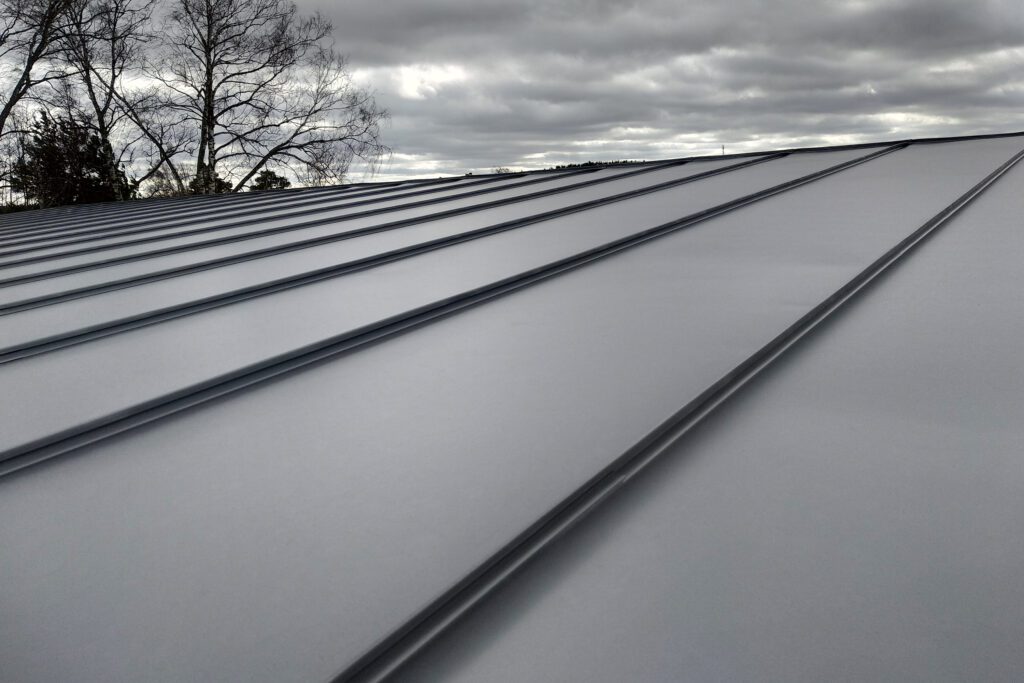
Definition and Types
Metal roofing uses metal materials like steel, aluminum, copper, and zinc to cover buildings. The main types include:
Standing Seam Metal Roofing: This type has raised seams connecting the panels, creating a watertight seal.
Corrugated Metal Roofing: Known for its wavy pattern, this is often used in agricultural settings but works well on commercial structures too.
Metal Roof Shingles: These mimic traditional shingles yet offer greater longevity and strength.
Benefits
There are several perks of choosing metal roofs:
Durability: They can last 50 years or more—a true long-term solution compared to other materials.
Energy Efficiency: Reflective coatings help reduce cooling costs by up to 25% (source needed).
Examples of these benefits make it clear why so many opt for metal roofing over asphalt shingles or wood shingles.
Lifespan
When installed correctly with quality materials—steel lasts around 40–70 years while copper stretches beyond that timeframe due mainly because oxidation protects rather than degrades it!
Material | Average Lifespan |
|---|---|
Steel | 40–70 years |
Copper | Over 70 years |
Wood Shingles and Shakes
Wood shingles and shakes offer a unique blend of natural beauty and durability that many homeowners find appealing. As someone who’s spent years exploring different roofing materials, I can tell you these wooden options are definitely worth considering.
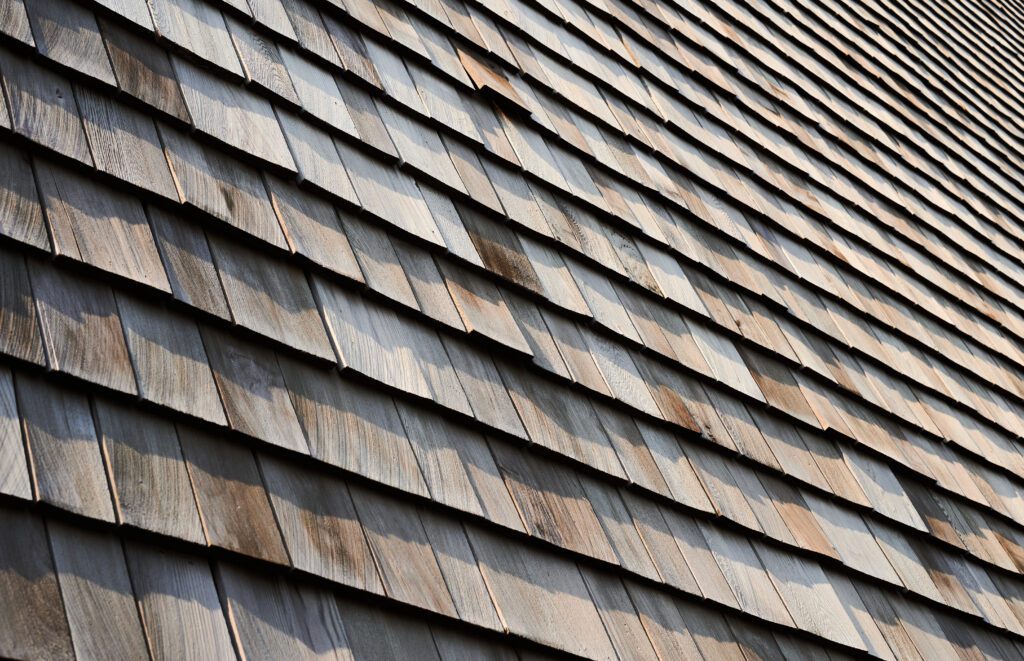
Definition And Types
Wood shakes and shingles come from natural wood, typically cedar or redwood. The main difference lies in their thickness and texture. Wood shingles are thin, wedge-shaped slabs produced by precise sawing while wood shakes are thicker wedges with a rougher texture made by splitting the wood.
Benefits
These materials bring several benefits:
Aesthetic appeal: They provide a distinct look that enhances any home’s appearance or roof type.
Durability: With proper maintenance, they can last up to 30 years or more.
Fire resistant: Compared to other roofing types like asphalt, they’re better at resisting fires due to treatments available for fire retardancy.
Lifespan
When well-maintained—cleaning debris off regularly—I’ve seen properly installed wood roofs lasting over three decades easily. This longevity makes them an excellent investment despite a higher upfront roof cost compared to some alternatives.
Material | Average Lifespan |
|---|---|
Cedar Shake | Up to 30+ years |
Redwood Shake | Up to 40+ years |
Maintenance Requirements
Maintaining these roofs involves regular inspections for damage caused by weather elements like wind or hail. Treating against moss growth helps too since moisture retention shortens lifespan significantly if left unchecked—a lesson learned firsthand after neglect led me into replacing part of my roof earlier than expected!
Maintenance tips include:
Removing leaves/debris promptly
Checking annually (or bi-annually) post severe storms
Applying preservative treatment every few years depending on climate conditions where you live; humid areas might require frequent applications compared to drier regions needing less often interventions
Slate Roofing
Slate roofing‘s an incredible option for anyone looking to combine durability and beauty in their roof. Let’s dive into what makes slate such a standout material.
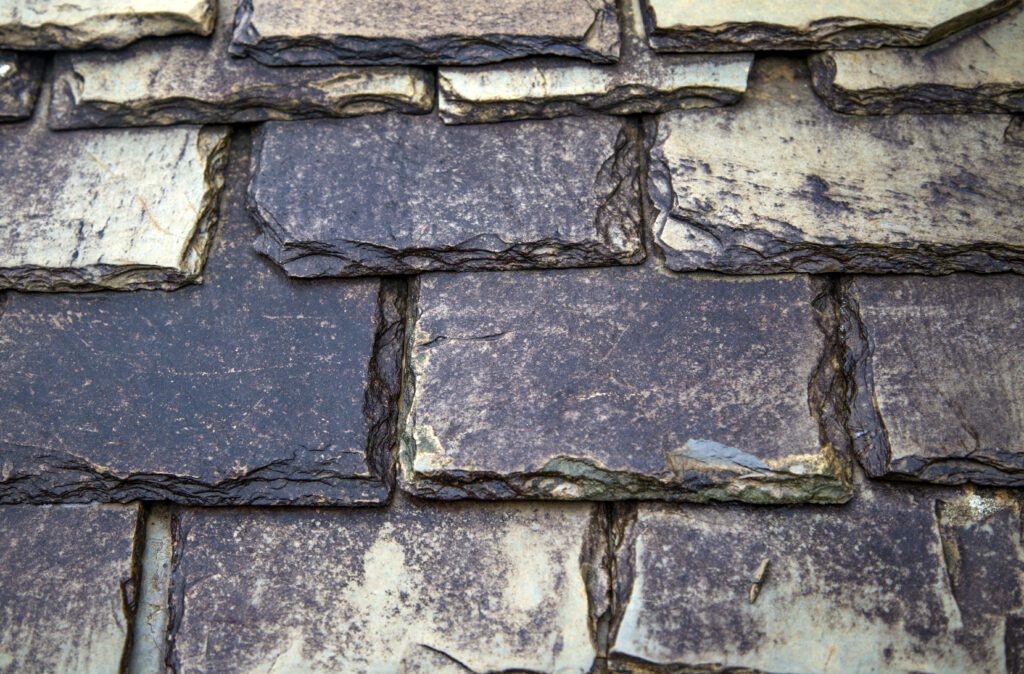
Definition and Composition
Slate roofing uses naturally mined slate tiles, along with accessories and other materials essential for installation. The key here is the fine-grained metamorphic rock that splits easily into thin layers, making it perfect for creating durable yet aesthetically pleasing tiles. While these tiles are fragile before installation, once they’re on your roof properly handled by roofing contractor professionals, they form one of the most resilient systems out there.
Benefits
There are several reasons why I love slate roofs:
Longevity: A well-maintained slate roof can last over 100 years which means it’s likely to outlive many buildings.
Aesthetic Appeal: You can’t beat the natural look of a slate roof! With its variety of colors and textures you can enhance any architectural style whether traditional or modern.
Fire Resistant: Safety first right? Slate is completely fire resistant adding an extra layer of protection to homes.
Lifespan
One thing that stands out about slate roofing is how long it lasts—over 100 years if taken care of properly. This isn’t just hearsay; historical structures worldwide have kept their original slates intact despite weathering centuries’ worth of storms, sun exposure, snow loads etc.
Cost and Installation Complexity
Now let’s talk money because good things don’t come cheap:
Initial cost – It’s higher compared to asphalt shingles or metal roofing but think long-term investment rather than short-term savings.
Installation complexity – Given its weight, specialized skills, equipment and time-consuming procedures involved this isn’t something DIY enthusiasts should attempt without professional help unless you’re willing risk damaging expensive materials not mention yourself! Definitely hire a professional roofing contractor here.
Alright moving swiftly onwards now shall we?
Synthetic Roofing Materials
Synthetic roofing materials are a game-changer in the world of roofing. They mimic natural products like slate and cedar but offer enhanced durability and performance.
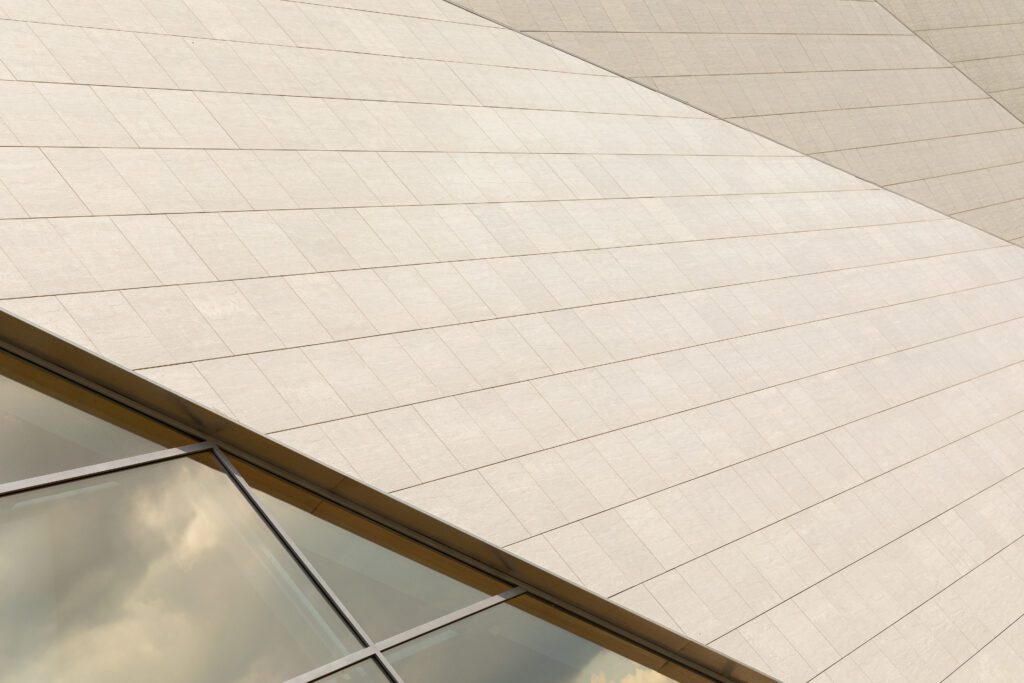
Definition And Types
These materials imitate the appearance of natural roofs while providing better longevity. They’re crafted from recycled rubber and plastic (yay to another green roof!) which undergo processing to form durable roofing solutions. You can find synthetic versions of traditional slates or wood shingles or shakes that look just as good, if not better.
Benefits
Durability And Longevity: These synthetics resist impact, water, wind, and algae growth and they are fire resistant.
Eco-Friendly: Made using recycled plastics and rubber; they help reduce carbon footprints, slotting them into the green roof category.
Cost-Effective: Lower maintenance costs compared to natural alternatives due to their resilience against various elements really helps to drive down the overall roof cost.
Lifespan
Expect these roofs to last 50 years or more with minimal upkeep—significantly longer than many other options on the market today thanks to their resistance properties mentioned earlier.
Environmental Impact
By utilizing recycled materials for production (like old tires), manufacturers minimize waste going into landfills—a win-win situation for homeowners who want a green roof and care about sustainability without compromising quality or aesthetics!


ROOFING VISUALIZER TOOL
See Your Home with a New Roof in Seconds
Help your homeowners visualize new roofing and colors on their own home with Renoworks’ AI technology in seconds.
- Easy-to-use interface designed for contractors and professionals working with homeowners.
Factors to Consider When Choosing Roofing Material
Choosing the right roofing material involves several key factors that can significantly impact your building’s performance and longevity. Let’s break down these essential considerations.
Climate and Weather Conditions
Climate plays a huge role in determining suitable roofing materials. In hot, sunny climates, I recommend clay tiles or slate since they withstand heat without fading or degrading. If you’re dealing with severe weather like heavy snowfalls or storms, metal roofs are ideal because of their impact resistance and ability to shed ice quickly. For colder regions needing good insulation against frigid temperatures, asphalt shingles paired with certain types of metal roofing work best as they support heavy snow loads effectively. Coastal homes benefit from materials resistant to salt spray and humidity; here again, metal roofs shine alongside synthetic options.
Cost and Budget
Budget constraints often dictate choices when it comes to replacing a roof—with roof costs typically between $5,500-$11,000 according to industry standards—with an average cost hovering around $8,314 for most homeowners (source: HomeAdvisor). Considering this significant expense helps narrow down feasible options, while balancing durability needs versus upfront spending capabilities ensures long-term satisfaction both financially & functionally speaking!
Conclusion
Choosing the right roofing material is a vital decision that impacts your home’s durability and aesthetic appeal. With options ranging from traditional clay tiles to advanced synthetic materials, it’s essential to weigh factors like climate suitability budget constraints and environmental benefits. By considering these elements you’ll ensure long-term satisfaction both financially and functionally making your investment in a new roof truly worthwhile.
Frequently Asked Questions
What are the benefits of traditional roofing options?
Traditional roofing materials like clay tiles, composite shingles, concrete tiles, metal roofing, and wood shakes offer durability and aesthetic appeal. Many of these materials are also eco-friendly.
Why is slate considered a good roofing material?
Slate roofs are known for their longevity (lasting over 100 years), fire resistance, and classic appearance. They require minimal maintenance compared to other natural products.
What makes synthetic roofing materials appealing?
Synthetic roofs mimic natural products such as slate and cedar but provide enhanced durability and performance. Made from recycled rubber or plastic, they last over 50 years with little upkeep.
Are synthetic roofs environmentally friendly?
Yes! Synthetic roofing materials reduce waste in landfills by using recycled content like rubber tires or plastics while providing long-lasting coverage that minimizes frequent replacements.
How do I choose the right roof for my climate?
Consider specific environmental challenges when choosing your roof—heat-resistant options for hot climates; snow-shedding designs for snowy regions; corrosion-resistant choices near coastal areas ensure optimal performance tailored to local conditions.
What's an average cost range for roof replacement?
The cost varies based on material type: asphalt shingles may be less expensive than high-end metals or slates. Balancing initial investment with lifespan helps achieve financial efficiency without compromising quality.


ROOFING VISUALIZER TOOL
See Your Home with a New Roof in Seconds
Help your homeowners visualize new roofing and colors on their own home with Renoworks’ AI technology in seconds.
- Easy-to-use interface designed for contractors and professionals working with homeowners.
Related Articles
Continue exploring this topic with these related articles, or read one of our case studies to see how visualization has helped remodelers save time and increase their profits.



